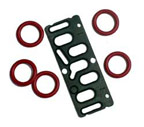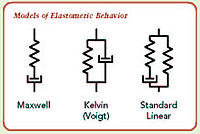
|
7108
S. Alton Way, Unit I |
(303) 758-2728
O-ring and Seal Design Theory
 The use
of an o-ring as a seal is mainly to prevent the transfer of fluid
(liquid, solid or gas) between two or more regions. The components
of the seal are the o-ring itself and the contact surfaces. The elastomeric
o-ring relies on a compressive force acting on the o-ring to prevent
the transfer of fluid between regions. Successful seal design ensures
adequate seal compressive force while optimizing the destructive stress
acting on the o-ring as a result of the compression or of the environment.
The use
of an o-ring as a seal is mainly to prevent the transfer of fluid
(liquid, solid or gas) between two or more regions. The components
of the seal are the o-ring itself and the contact surfaces. The elastomeric
o-ring relies on a compressive force acting on the o-ring to prevent
the transfer of fluid between regions. Successful seal design ensures
adequate seal compressive force while optimizing the destructive stress
acting on the o-ring as a result of the compression or of the environment.
Three Models for Characterizing Viscoelastic Behavior Are:
- Maxwell Model (dashpot and spring in series)
- Kelvin (Voigt) Model (dashpot and spring in parallel)
- Standard Linear Solid (dashpot and spring in series with a spring in parallel).*
O-ring and Seal Design Topics
Incompressibility, Viscoelasticity and Thermomechanical Considerations
Nonlinear Finite Element Analysis (FEA)
Static Gland Dimensions - Axial-Static Glands
Static Gland Dimensions - Axial Vacuum - Static Glands
Static Gland Dimensions - Trapezoidal Vacuum
Static Gland Dimensions - Conical
Static Gland Dimensions - Tube Fitting Boss Seals
Static Gland Dimensions - Radial
Dynamic Gland Dimensions - Rotary Seals
Dynamic Gland Dimensions - Reciprocating Seals
Gland Design 1 - Special Considerations, Part 1
Gland 2 - Special Considerations, Part 2
Gland 3 - Special Considerations, Part 3
Elastomers for Semiconductor Plasma Environments
O-Rings and Seals in Vacuum Environments
* © Photographer: David Lemery of Milpitas, California, USA
We are located in the Denver Technological
Center in a suburb of Denver, Colorado
©1997-2017, Problem Solving Products, Inc.
Website Map | Privacy Statement
| Terms of Use



